 |
Me emociona y me llena de una alegría inexplicable cada vez que lo presencio. El Poornahuthi (ofrenda final) en el día Vijayadashami (décimo día de Dasara) del Veda Purusha Saptaha Jnana Yajna de 7 días que se celebra anualmente en Prasanthi Nilayam es algo que tiene que ser experimentado de primera mano para sentir lo que estoy sintiendo. Los eruditos y sacerdotes védicos levantan la mano para verter el Ghee junto con el paquete de seda que contiene la gran ofrenda final para el Yajna.. Las llamas del pozo sagrado se elevan más, ansiosas por aceptar la ofrenda. Ir aún más alto es el tono de los cantos sagrados que emanan de mil gargantas a medida que Sus alumnos se unen a los sacerdotes para posiblemente recrear escenas de la antigua Sathya Yuga, la Edad de Oro. Sin embargo, ninguno de estos se eleva tanto como los niveles de asombro y emoción de los participantes, activos o silenciosos, que se han reunido en la aldea sagrada para experimentar esto. La brillante vestimenta de azafrán de todos los que están en el estrado haciendo la ofrenda recuerda al Ser que es el epítome del sacrificio: Bhagawan Baba, nuestro querido Swami. ¡Las ardientes llamas anaranjadas que lamían las ofrendas también le recuerdan al mismo Ser, el Veda Purusha , el Yajna Purusha , nuestro querido Swami!
Creo que estaba destinado a ser así porque cualquier cosa que Swami lanza siempre tiene a la vista a largo plazo. La impresionante historia del Veda Purusha Saptaha Jnana Yajna lo muestra claramente. Si bien el Yajna en sí mismo es un paso glorioso hacia la reactivación del interés del hombre en el mayor objetivo de la vida, Swami no se detuvo en eso. Para ayudar a todos a comprender mejor el significado, también inició el Prasanthi Vidwan Mahasabha. Esa es otra historia fascinante para leer.
Nacimiento del Prasanthi Vidwan Mahasabha
Fue en la víspera del día de Ramanavami (1 de abril de 1963 según los registros de Sanathana Sarathi), cuando millones de personas en todo el mundo se preparaban para celebrar el nacimiento del Señor Rama cuando Swami hizo algo muy especial. Estaba entonces en Rajahmundry, la ciudad a orillas del río Godavari, considerada hoy como la capital cultural de Andhra Pradesh. La ciudad estaba llena de devotos que llegaban en autobús, bote, tren y automóvil desde Cuttack, Visakhapatnam, Koraput, Bobbili, Kakinada, Chebrol, Bezvada, Hyderabad, Warangal, Guntur y desde docenas de pequeñas aldeas a la orilla del mar y de las grandes ciudades del interior. Todos los vehículos de transporte público resoplaron y se abrieron camino hacia Rajahmundry con sus enormes cargas humanas, ¡pero se fueron silbando alegremente porque todos estaban ansiosos por venir pero ninguno quería irse!
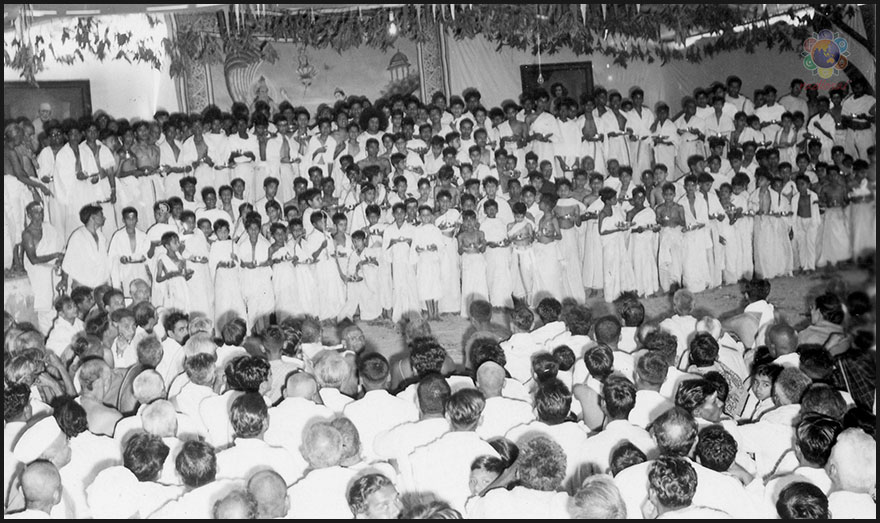 |
Los dos días allí vieron a Swami bendiciendo a los devotos con darshan, sparshan y sambhashan en un estadio de casi seis acres de tamaño. Los días 29 y 30 de marzo, académicos como el Dr. B Ramakrishna Rao, el ex gobernador de Kerala y Uttar Pradesh, Brahmasri Uppuluri Ganapathi Sastri, Brahmasri Remilla Suryaprakasa Sastry y Sri Jatavallabhula Purushottam se dirigieron a la reunión durante unos minutos cada uno, antes de Swami. discurso. La multitud seguía creciendo e incluso el estadio parecía estallar en sus costuras. Para satisfacer la sed y el anhelo de los miles reunidos, Swami también otorgó darshan y un discurso divino desde la azotea de la casa en la que residía mientras los devotos se apiñaban en los terrenos vacíos adyacentes.
A pesar de este frenesí devocional, Swami tenía un plan especial para el 1 de abril. Reuniendo un grupo especial de expertos, eruditos y algunos devotos, Swami partió hacia el río después del anochecer. Luego, recogiendo una lancha motora, el grupo se lanzó hacia un destino desconocido. Swami guió al conductor del bote a un lugar seco de arena sobre el Dowleswaram anicut (que hoy se ha convertido en un aluvión). Allí, todos se bajaron del bote y Swami les pidió a los eruditos que eligieran un lugar para sentarse. Pronto, el grupo se sentó acurrucado alrededor de Swami, bañado por la fresca luz de la luna contra el fondo del río azul como la tinta.
 | |
| Cuando Swami llegó al lanzamiento del motor, tenía un plan maestro listo |
Swami habló sobre el estado del mundo y dijo que India debe guiarlo con la lámpara de Sanathana Dharma. "Debemos reformar los hábitos del hombre; reconstruir su personaje; reacondicionar sus ideales y modos de vida; ayúdelo a recuperar la herencia espiritual que ahora es alentado a ignorar por los protagonistas de la prosperidad material y la felicidad monetaria ", declaró Swami enfáticamente. ¡Lo que sucedió después, dejó sin aliento a todos!
Con la música de fondo del canto bhajan de los devotos elegidos, Swami hundió su mano en las arenas y sacó ídolos de Rama, Sita, Lakshmana y Hanuman. Luego, antes de que los eruditos pudieran recuperarse de la emoción, creó un ídolo encantador del Señor Nataraja, el Señor de la danza Shiva. Hubo una admiración asombrada que se rompió con un anuncio aún más sorprendente,
"He decidido establecer el Prasanthi Vidwan Mahasabha, una Academia de eruditos védicos de toda la India que se esforzará por despertar a la humanidad a la necesidad de alcanzar el Prasanthi (Paz Suprema) que tiene su Nilayam (Morada) en el Sanathana Dharma, consagrado en las antiguas escrituras de la India ".
La 'gran reunión de eruditos para promover la paz suprema'
El Prasanthi Vidwan Mahasabha se inauguró formalmente junto con el Swadhyaya Sapthaha Yajna el 20 de octubre de 1963 , durante el festival Dasara. Alrededor de 200 expertos se habían reunido en Prasanthi Nilayam para la 'Convocación'. Casualmente, también fue el día en que aparecieron las farolas en Puttaparthi y se le pidió a Swami que inaugurara el mismo.
Hablando ese día, Swami dijo: "¡Ahora, me has pedido que encienda estas luces de la calle, y has mencionado que este es un momento supremo, ya que el pueblo debe estar libre de la oscuridad y lleno de luz de aquí en adelante! Permíteme decirte que este pueblo no está recibiendo luz hoy. ¡Obtuvo la Luz el día que este Shakti nació en este lugar! ¿Qué es esta pequeña luz que ilumina unos pocos metros alrededor de cada poste en comparación con la Luz que ilumina el corazón y difunde alegría y paz?
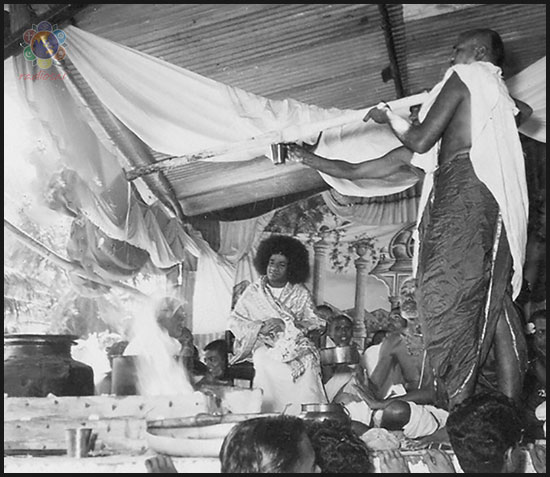 | |
| El 'Sustentador de flores' inmerso en su tarea de Vidwat Poshana |
Al declarar el propósito de iniciar el Prasanthi Vidwan Mahasabha, Swami declaró: "La cultura de Bharat (India) que da fuerza y mantiene la paz ha sido sumergida por los llamativos y brillantes tratos introducidos desde Occidente durante siglos de dominio extranjero. La atención de la gente de esta tierra es atraída desde las alturas hacia las necesidades humildes de los sentidos y el estómago. Incluso después de que los indios recuperaron el poder de dar forma a su propio futuro, la situación no ha mejorado, ya que se perpetúa la misma actitud perjudicial. ¡Las creencias y prácticas del pasado son condenadas como supersticiones por los herederos de esa herencia! No voy a estar de acuerdo con las personas que los descartan como supersticiones, porque ellos dieron a los que creen y actuó de acuerdo con la creencia, el tesoro más preciado de la dicha y la paz ( ananday shanti ). Ayudaron a sacar los colmillos venenosos del karma , colmillos que inyectan avaricia, egoísmo y odio.
Entonces, al igual que el fabricante de guirnaldas que selecciona flores de varios tonos, tamaños y fragancias para preparar una guirnalda, la Prasanthi Vidwan Mahasabha (Sociedad de expertos) también ha seleccionado estos expertos y ha preparado una guirnalda. El propósito de esta Sociedad es recordar a todos el papel del héroe que tienen que jugar. ¡Por supuesto, soy el sustentador de las flores, no el fabricante de guirnaldas! "
El Dr. Burgula Ramakrishna Rao, un gran erudito en sánscrito y telugu, un célebre lingüista, un gran trabajador social y líder político que sirvió al pueblo como Ministro Principal de Andhra y Gobernador de Kerala y Uttar Pradesh, fue nombrado Presidente de Sabha. Debajo de él había un Comité Central de Expertos que se había ganado una fama duradera por su beca, discursos y escritos como Uppuluri Ganapathi Sastry (honrado como Amnayarthavachaspathi por sus colegas), Kolluri Somasekhara Sastry (honrado como Kulapathi por sus estudiantes gratificados), Bulusu Appanna Sastry (conocido como Darsanalankara), Remilla Suryaprakasa Sastry (honrado como Sanga Veda Vidya Bhaskara), Varanasi Subramanya Sastry (celebrado como Balavyasa), Ghandikota Subrahmanya Sastry (la reliquia entre los eruditos de Dharmasastra que visualizaron el Sai Gayatri) y el maestro de la tradición védica,
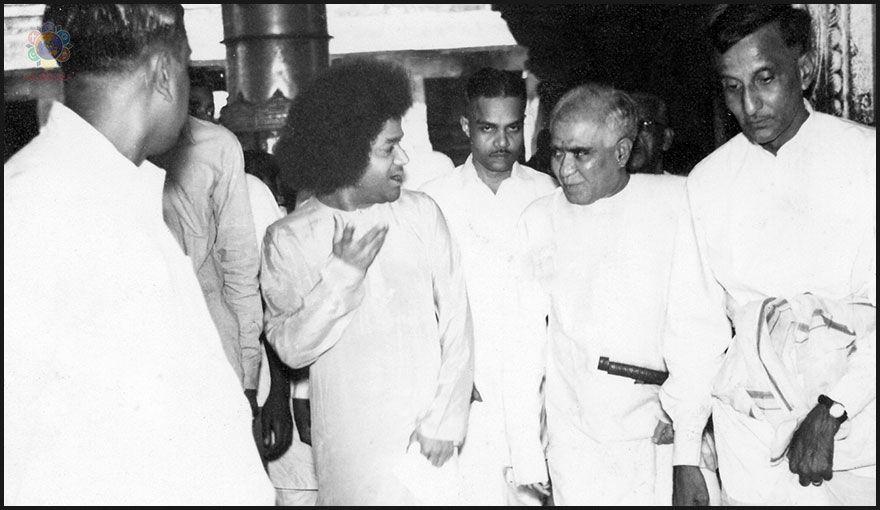 |
| Swami nombró al Dr. Burugula Ramakrishna Rao (segundo desde la derecha) como Presidente de Prasanthi Vidwan Mahasabha |
Al día siguiente, 21 de octubre de 1963 , Swami, una vez más, entusiasmó a los miembros del recién creado Mahasabha, "Bhavani entregó una espada en las manos del Emperador Sivaji y le encargó aventurarse y defender Sanathana Dharma; este Siva-Shakti te está dando hoy la espada del coraje y el encargo de salir y revivir el Dharma en el mundo ".
El florecimiento del Mahasabha
Cuanto más profundas son las raíces, menos evidentes son en la superficie. Su presencia está indicada sutilmente por la fruta fresca producida por el árbol, año tras año. Del mismo modo, el pequeño retoño que Swami plantó décadas antes se está convirtiendo en un árbol más fuerte con raíces más profundas, año tras año. Una indicación son las celebraciones anuales de Dasara en Puttaparthi. El Prasanthi Vidwan Mahasabha, se ha convertido en una parte integral de las celebraciones de Dasara en Prasanthi Nilayam. Todas las noches del Veda purusha Saptaha Jnana Yajna de siete días, hay charlas sobre temas espirituales seguidas del Discurso Divino (se reproduce una grabación después de 2011).
El hecho interesante es que estas charlas ya no son entregadas solo por los eruditos védicos tradicionales. Los devotos, maestros y estudiantes (de las instituciones educativas de Swami) que han absorbido, experimentado y se han sentido conmovidos por las reuniones de amor divino como expresión de su gratitud a Swami. Sus charlas son tan inspiradoras como las de los eruditos eruditos porque, después de todo, ¿no hay un solo idioma: el del corazón? Y cuando el corazón habla, el corazón definitivamente escucha.
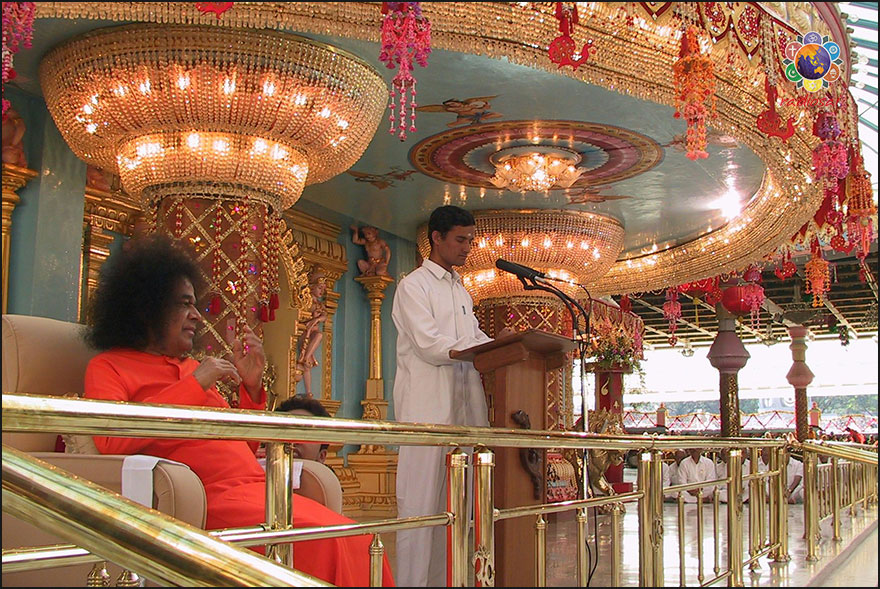 |
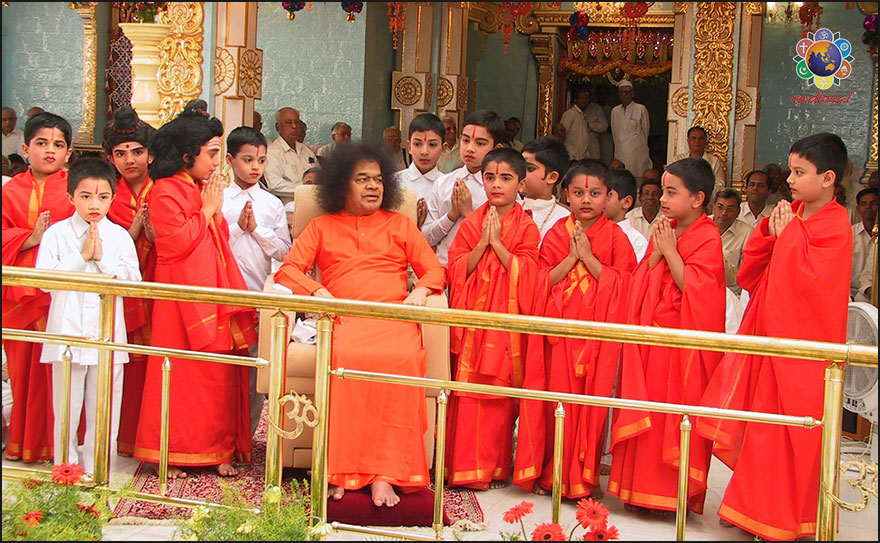 |
La exclusividad del Mahasabha y el Veda Purusha Saptaha Jnana Yajna ha sido abrumada por la inclusión que Swami ha fomentado y desarrollado. Los devotos, maestros y estudiantes también participan en los diversos cantos, lecturas y parayanams durante el curso del Yajna . Cantan los himnos y encantamientos en Swasthi (alternativamente) con los eruditos y sacerdotes. Son una parte integral del Poornahuthi o la gran ofrenda final. En los últimos tiempos, también se unen con los sacerdotes para repartir rociando las benditas aguas perfumadas de gracia sobre todos los reunidos. La fuerza humana que se ha preparado lenta pero seguramente para la tarea de Dharmasthapana , Vedasamrakshanay Vidwathposhana (establecimiento del Dharma, protección de los Vedas y fomento de los eruditos védicos - Swami había declarado que estas eran partes esenciales de su misión avatarica) es un espectáculo inspirador para la vista.
Me recuerda las declaraciones de Swami del 20 de octubre de 1963: "Los miembros del Prasanthi Vidwan Mahasabha tienen que compartir su aprendizaje, su experiencia y su alegría con la gente, ese es su deber primario. Para esto, no deben recibir ningún beneficio monetario, ya que solo están cumpliendo con su deber, aumentando su propia alegría, compartiendo su propio entusiasmo. Estoy seguro de que este salón de actos se moverá de victoria en victoria, ya que contribuye a mi trabajo. ¡Este enorme auditorio fue erigido, lo creerías, en 15 días! Todo fue hecho por los devotos; no se empleó ni un solo coolie (trabajador). El río Chithravathi ayudó mucho, porque suministró la arena con la que se llenó el lugar. Ningún gobierno, ninguna fuerza de autoridad podría haber logrado esto tan pronto; solo la devoción puede inspirar esta fe firme y constante. Es todo el efecto de la Voluntad. La Voluntad está allí, por lo que el gran salón también llevará a cabo su gran tarea, sin obstáculos.
Que esas palabras divinas llenen nuestros corazones de alegría y un sentido de responsabilidad.
Samastha Lokaha Sukhino Bhavantu .
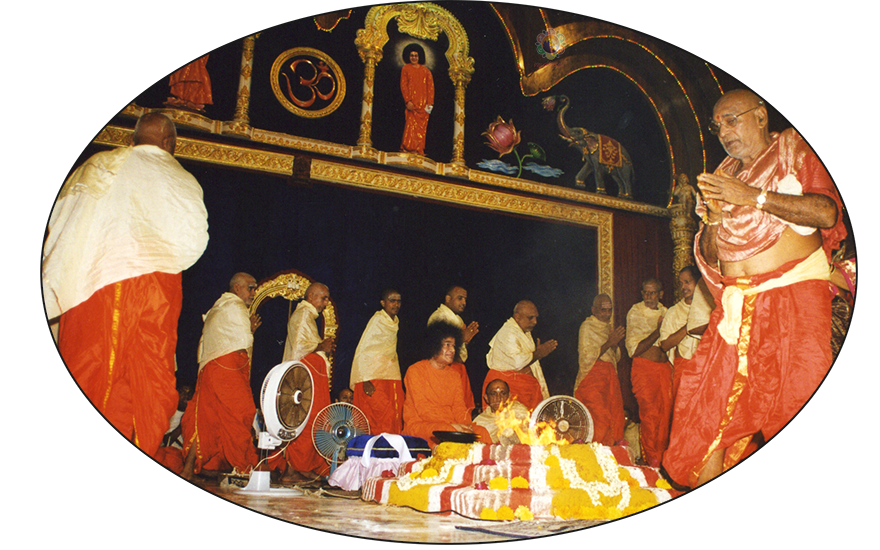 |
Aravind Balasubramanya
Team Radio Sai
TRADUCCION NO OFICIAL
Prasanthi Vidwan Mahasabha
- the story of a sapling which has grown into a tree
 |
It thrills me and fills me with some inexplicable joy every time I witness it. The Poornahuthi (final offering) on the Vijayadashami day (10th day of Dasara) of the 7-day Veda Purusha Saptaha Jnana Yajna held annually at Prasanthi Nilayam is something that has to be experienced first-hand to feel what I am feeling. The Vedic scholars and priests raise their hands to pour the Ghee along with the silk bundle containing the grand final offering for the Yajna. The flames from the sacred pit rise higher, eager to accept the offering. Going even higher is the pitch of sacred chants emanating from a thousand throats as His students join the priests to possibly recreate scenes from the bygone Sathya Yuga, the Golden Age. However, none of these rise as high as the awe and emotion levels of the participants, active or silent, who have gathered in the holy hamlet to experience just this. The bright saffron vesture of all those on the dais making the offering reminds one of the Being who is the epitome of sacrifice - Bhagawan Baba, our dear Swami. The fiery orange flames lapping up the offerings also remind one of the same Being - the Veda Purusha, the Yajna Purusha - our dear Swami!
I think it was meant to be this way because anything that Swami launches is always keeping the long-term in view. The awe-inspiring history of the Veda Purusha Saptaha Jnana Yajna clearly shows that. While the Yajna itself is a glorious step towards the revival of man's interest in the greatest goal of life, Swami did not stop at just that. To help everyone understand the significance better, He also initiated the Prasanthi Vidwan Mahasabha. That is another riveting story to read.
Birth of the Prasanthi Vidwan Mahasabha
It was on the eve of the Ramanavami day (April 1, 1963 as per Sanathana Sarathi records), when millions around the world were preparing to celebrate the birth of Lord Rama that Swami did something very special. He was then in Rajahmundry, the city on the banks of the Godavari river which is considered today as the cultural capital of Andhra Pradesh. The city had been packed to the full with devotees flowing in by bus, boat, train and car from Cuttack, Visakhapatnam, Koraput, Bobbili, Kakinada, Chebrol, Bezvada, Hyderabad, Warangal, Guntur and from dozens of tiny hamlets by the seashore and from big towns in the interior. All public transport vehicles huffed and puffed their way towards Rajahmundry with their huge human loads but left whistling merrily because all were eager to come but none wanted to leave!
 |
The two days there saw Swami blessing the devotees with darshan, sparshan and sambhashan in a stadium measuring nearly six acres in size. On the 29th and 30th of March, scholars like Dr B Ramakrishna Rao, the former Governor of Kerala and Uttar Pradesh, Brahmasri Uppuluri Ganapathi Sastri, Brahmasri Remilla Suryaprakasa Sastry and Sri Jatavallabhula Purushottam addressed the gathering for a few minutes each, prior to the Swami's discourse. The crowds kept swelling and even the stadium seemed to be bursting at its seams. To satisfy the thirst and yearning of the gathered thousands, Swami also granted darshan and a divine discourse from the roof-top of the home He was residing in as the devotees packed into the adjacent empty grounds.
Despite this devotional frenzy, Swami had a special plan for the 1st of April. Gathering a special group of Pundits, scholars and a few devotees, Swami set off for the river after dusk. Then, picking a motorboat, the group launched off towards an unknown destination. Swami guided the boat-driver to a dry patch of sand above the Dowleswaram anicut (which has become a barrage today). There, everyone got off the boat and Swami asked the scholars to pick a spot to sit. Soon, the group sat huddled around Swami, bathed in the cool moonlight against the background of the ink-blue river.
 | |
| When Swami got on to the motor launch, He had a Masterplan ready |
Swami spoke on the state of the world and said that India must guide it with the lamp of Sanathana Dharma. "We must reform the habits of man; reconstruct his character; recondition his ideals and modes of living; help him regain the spiritual heritage which he is now encouraged to ignore by protagonists of material prosperity and monetary happiness," Swami stated emphatically. What happened next, took everyone's breath away!
To the background music of bhajan-singing by the chosen devotees, Swami plunged His hand into the sands and pulled out idols of Rama, Sita, Lakshmana and Hanuman. Then, before the scholars could recover from the thrill, He created a charming idol of Lord Nataraja, the dancing Lord Shiva. There was a stunned admiration which was broken by an even more stunning announcement,
"I have decided to establish the Prasanthi Vidwan Mahasabha, an All-India Academy of Vedic Scholars who will strive to awaken humanity to the need to attain the Prasanthi (Supreme Peace) which has its Nilayam (Abode) in the Sanathana Dharma, enshrined in the ancient scriptures of India."
The 'great gathering of scholars to promote supreme peace'
The Prasanthi Vidwan Mahasabha was formally inaugurated along with the Swadhyaya Sapthaha Yajna on October 20, 1963, during the Dasara festival. About 200 Pundits had assembled at Prasanthi Nilayam for the 'Convocation'. Coincidentally, it was also the day when streetlights made their appearance in Puttaparthi and Swami was requested to inaugurate the same.
Speaking on that day, Swami said, "Now, you have asked Me to switch on these streetlights, and you have mentioned that this is a supreme moment, for the village is to be free from darkness and full of light hereafter! Let Me tell you, this village is not getting light today! It got the Light the day this Shakti took birth in this place! For what is this little light that illumines just a few yards around each pole when compared with the Light that illumines the heart and spreads joy and peace."
 | |
| The 'Sustainer of Flowers' immersed in His task of Vidwat Poshana |
Stating the purpose behind initiating the Prasanthi Vidwan Mahasabha, Swami stated, "The culture of Bharat (India) which gives strength and sustains peace has been submerged by the flashy, glittering deals introduced from the West during centuries of foreign rule. The attention of the people of this land is drawn from the heights to the lowly needs of the senses and the stomach. Even after Indians regained the power to shape their own future, the situation has not improved, for the same injurious attitude is being perpetuated. The beliefs and practices of the past are condemned as superstitions by the inheritors of that very heritage! I won't agree with people who dismiss them as superstitions, for they gave those who believed and acted according to the belief, the most precious treasure of bliss and peace (ananda and shanti). They helped to pull out the poisonous fangs of karma, fangs that inject greed, egoism, and hate.
So, like the garland maker who selects flowers of various hues, sizes, and fragrances for preparing a garland, the Prasanthi Vidwan Mahasabha (Society of Pundits) too has selected these pundits and prepared a garland. The purpose of this Society is to remind everyone of the role of the hero they have to play. Of course, I am the sustainer of the flowers, not the garland maker!"
Dr Burgula Ramakrishna Rao, a great scholar in Sanskrit and Telugu, a celebrated linguist, a great social worker and political leader who served the people as Chief Minister of Andhra and Governor of Kerala and Uttar Pradesh, was made the President of the Sabha. Under him was a Central Committee of Pundits who had earned enduring fame by their scholarship, speeches and writings like Uppuluri Ganapathi Sastry (honoured as Amnayarthavachaspathi by his colleagues), Kolluri Somasekhara Sastry (honoured as a Kulapathi by his gratified students), Bulusu Appanna Sastry (known as Darsanalankara), Remilla Suryaprakasa Sastry (honoured as Sanga Veda Vidya Bhaskara), Varanasi Subramanya Sastry (celebrated as Balavyasa), Ghandikota Subrahmanya Sastry (the doyen among Dharmasastra scholars who visualized the Sai Gayatri) and the master of Vedic lore, Pisipati Krishnamurthi Sastry.
 |
| Swami appointed Dr Burugula Ramakrishna Rao (second from right) as the President of the Prasanthi Vidwan Mahasabha |
The next day, October 21,1963, Swami once again enthused members of the newly created Mahasabha, "Bhavani gave a sword into the hands of the Emperor Sivaji commissioning him to venture forth and uphold Sanathana Dharma; this Siva-Shakti is today giving you the sword of courage and commissioning you to go forth and revive Dharma in the world."
The blossoming of the Mahasabha
The deeper the roots go, the less apparent they are at the surface. Their presence is subtly indicated by the fresh fruit yielded by the tree, year after year. In the same way, the tiny sapling which Swami planted decades before is growing into a stronger tree with deeper roots, year after year. One indication is the annual Dasara celebrations in Puttaparthi. The Prasanthi Vidwan Mahasabha, has become an integral part of Dasara celebrations in Prasanthi Nilayam. Every evening of the seven-day Veda purusha Saptaha Jnana Yajna, there are talks on spiritual themes followed by the Divine Discourse (a recording is played post 2011).
The interesting fact is that these talks are no longer delivered by the traditional Vedic scholars alone. Devotees and teachers and students (from Swami's educational institutions) who have imbibed, experienced and been touched by the Divine Love address gatherings as an expression of their gratitude to Swami. Their talks are as inspiring as the ones delivered by erudite scholars because, after all, isn't there only one language - that of the heart? And when the heart speaks, the heart definitely listens.
 |
 |
The exclusivity of the Mahasabha and the Veda Purusha Saptaha Jnana Yajna has been overwhelmed by the inclusivity which Swami has fostered and developed. The devotees, teachers and students also participate in the various chantings, readings and Parayanams during the course of the Yajna. They chant the hymns and incantations in Swasthi (alternatively) with the scholars and priests. They are an integral part of the Poornahuthi or the final grand offering. Of late, they also team up with the priests to go around sprinkling the benedictory perfumed waters of grace on all assembled. The human-force that has slowly but surely been prepared for the task of Dharmasthapana, Vedasamrakshana and Vidwathposhana (establishment of Dharma, protection of the Vedas and fostering of Vedic Scholars - Swami had declared that these were essential parts of His Avataric mission) is an inspiring sight to behold.
It reminds me of Swami's statements on the 20th of October, 1963, "The members of the Prasanthi Vidwan Mahasabha have to share their learning and their experience and their joy with the people, that is their elementary duty. For this, they are not to receive any monetary benefits, for they are only doing their duty, increasing their own joy, sharing their own enthusiasm. I am sure this assembly hall will move from victory to victory, for it is contributory to My work. This huge auditorium was erected, would you believe it, in 15 days! It was all done by the devotees; not a single coolie (labourer) was employed. The Chithravathi river helped a good deal, for it supplied the sand with which the place was filled. No government, no force of authority could have achieved this so soon; only devotion can inspire this consistent firm faith. It is all the effect of Will. The Will is there, so the great hall also will carry on its great task, unhindered."
May those divine words fill our hearts with joy and a sense of responsibility.
Samastha Lokaha Sukhino Bhavantu.
 |
Aravind Balasubramanya
Team Radio Sai






















No hay comentarios :
Publicar un comentario